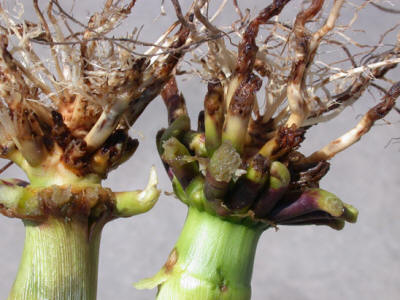|

by Tony Isaacs
June 22, 2012
from
NaturalNews Website
|
About the author
Tony Isaacs, is a natural health author, advocate and
researcher who hosts The Best Years in Life website for
those who wish to avoid prescription drugs and
mainstream managed illness and live longer, healthier
and happier lives naturally.
Mr. Isaacs is the author of
books and articles about natural health, longevity and
beating cancer including "Cancer's Natural Enemy" and is
working on a major book project due to be published
later this year.
He is also a contributing author for
the worldwide advocacy group
"S.A N.E.Vax. Inc" which
endeavors to uncover the truth about
HPV vaccine
dangers. |

Root damaged corn.
University of
Illinois Bulletin
Corn genetically engineered by Monsanto to kill western corn
rootworm is reportedly being devoured by those pests with a
vengeance.
Thanks to heavy reliance on the
genetically modified (GM) crops, the tiny rootworm pest has
overtaken fields, outsmarting the genetic engineering that was
supposed to keep it away.
Nature fights
back against GM corn
The GM corn, launched in 2003, is engineered to produce a protein,
known as
Cry3Bb1, derived from a bacterium
known as
Bacillus thuringiensis, or Bt.
In theory, rootworms ingest Bt corn
roots and the protein is fatal. However, recent reports indicate
that pesticide-resistant rootworms are showing up weeks earlier and
more voraciously than ever.
In a research paper published in the July/August/September 2012
issue of the journal GM Crops & Food, scientists reported
that samples taken in 2010 indicated that rootworm populations had
an eleven-fold survival rate on Cry3Bb1 maize than did control
populations. The paper noted that resistant corn rootworm
populations first identified in 2009 had three-fold survival rates
on Cry3Bb1 maize at that time compared to other populations.
Mike Gray, a professor of entomology with the University of
Illinois reported:
"We're still early in the growing
season, and the adults are about a month ahead of schedule,"
explained Gray. "I was surprised to see them - and there were a
lot."
Reports of increasing rootworm damage
began coming in last year after Iowa State University researcher
Aaron Gassmann published a study saying that the rootworms in
Iowa were becoming resistant to GM corn, creating so-called
"superbugs."
Farmers in several states found that the
western corn rootworm was surviving after ingesting an insecticidal
toxin produced by the corn plants.
With both demand and prices high, many farmers are planting corn
year after year and on more acres, increasing the possibility that
resistance could develop. Typically, corn farmers have had to rotate
corn crops to minimize pest pressures. But with Bt corn, many simply
planted "corn on corn," year after year.
Federal regulators require a 20 percent
"refuge" of non-Bt corn near Bt acres, but many growers have ignored
that and oversight has been lax.
The new "superbug" rootworms may lead to serious financial woes for
both farmers and the rest of us, according to a letter sent to the
Environmental Protection Agency (EPA)
by 22 prominent scientists and corn-management experts from the U.S.
Department of Agriculture and universities across the Midwestern
Corn Belt.
Patrick Porter, PhD, associate
professor at Texas A&M University, who drafted the letter, noted
that farmers are paying almost twice as much for seeds that don't
live up to their promises, and are then having to resort to
insecticides on top of that.
The potential result, according to Porter, is crop failure which
could raise food prices at the grocery store.
Porter said,
"If farmers start taking damage
(from) any pest, that will lower yields. That will reduce the
supply of corn and increase prices."
Porter also noted that when prices for
corn go up, more farmers start planting corn despite the risks, and
when growers shift to growing more of one crop, they grow less of
other crops and those crops' prices also go up.
Adding to GM crop concerns, recent research from Canadian scientists
found that pesticides used on genetically modified (GM) crops and,
in some cases, the genes used to create GM crops are able to survive
in our digestive tracts, move into our bloodstreams and, in the case
of pregnant women, show up in their developing infants.
The research contradicts
repeated contentions by Monsanto and the EPA that 'only'
insects would be 'hurt' by GM crops.
Sources
|

